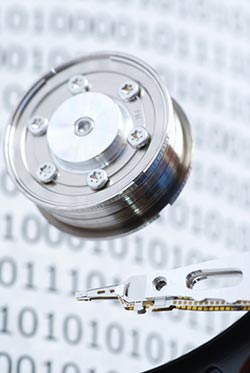Data storage: Making the switch

A three-layer sandwich of magnetic materials could help to pack more data on to hard drives.<br><br>© Zoonar/Thinkstock<br>
A ‘sandwich’ of three iron alloy layers could help to create computer hard drives that can store more data than ever before. Tiejun Zhou and co-workers at the A*STAR Data Storage Institute in Singapore expect that their development, based on a new technology called heat-assisted magnetic recording (HAMR), could boost the capacity of disks.
Conventional hard drives contain a tiny electromagnet — a write head — that hovers over a spinning disk coated with a ferromagnetic material. The electromagnet induces the magnetic field within small regions of the disk to point either up or down, encoding one bit of data.
Heat can jumble these magnetic bits and destroy the data. The latest disks use materials with a very large coercivity — a measure of how difficult they are to demagnetize. However, write heads must exert even greater magnetic fields to encode data in such materials. The balance between bit size, coercivity and the electromagnet's strength ultimately puts an upper limit on disk density of about 1 terabit per square inch.
In HAMR systems, each recording region is briefly heated above its Curie temperature, a point when magnetic coercivity drops significantly and a much smaller field can write the bit. Once the region cools, the coercivity rises and the bit locks into place.
Zhou’s team found a way to reduce both the writing temperature and the switching field in HAMR systems. The upper iron–platinum layer of the sandwich stores data bits; the lower iron–cobalt layer helps to channel the write-head’s magnetic field, enabling data writing; and the middle iron–rhodium layer acts as a switch between the two. The middle layer is antiferromagnetic at room temperature so blocks any magnetic coupling between the other layers. At about 350 kelvin, however, it becomes ferromagnetic, allowing the layers to couple.
Iron–platinum normally has a Curie temperature of about 750 kelvin, but that plummets when coupled to the iron–cobalt layer. Data can therefore be written to the iron–platinum layer once the iron–rhodium layer becomes ferromagnetic, at about 350 kelvin.
Coupling also reduces the coercivity of the iron–platinum layer, so a write head would need only to generate one-third of the usual magnetic field to encode a bit. “Theoretically, the bit can occupy a space as small as 100 square nanometers,” says Zhou. The team now plans to reduce the size of the nanocrystals in each data region of the iron–platinum layer, while maintaining its high coercivity.
The A*STAR-affiliated researchers contributing to this research are from the Data Storage Institute
Journal information
Zhou, T. J., Cher, K., Hu, J. F., Yuan, Z. M. & Liu, B. The concept and fabrication of exchange switchable trilayer of FePt/FeRh/FeCo with reduced switching field. Journal of Applied Physics 111, 07C116 (2012).
Media Contact
All latest news from the category: Materials Sciences
Materials management deals with the research, development, manufacturing and processing of raw and industrial materials. Key aspects here are biological and medical issues, which play an increasingly important role in this field.
innovations-report offers in-depth articles related to the development and application of materials and the structure and properties of new materials.
Newest articles

A new look at the consequences of light pollution
GAME 2024 begins its experiments in eight countries. Can artificial light at night harm marine algae and impair their important functions for coastal ecosystems? This year’s project of the training…

Silicon Carbide Innovation Alliance to drive industrial-scale semiconductor work
Known for its ability to withstand extreme environments and high voltages, silicon carbide (SiC) is a semiconducting material made up of silicon and carbon atoms arranged into crystals that is…

New SPECT/CT technique shows impressive biomarker identification
…offers increased access for prostate cancer patients. A novel SPECT/CT acquisition method can accurately detect radiopharmaceutical biodistribution in a convenient manner for prostate cancer patients, opening the door for more…





















